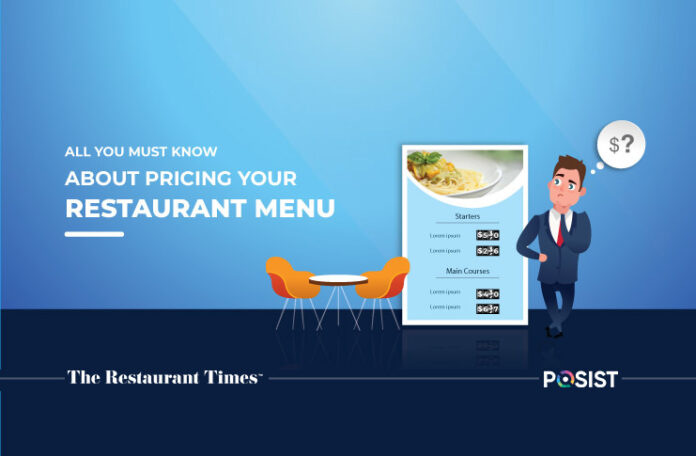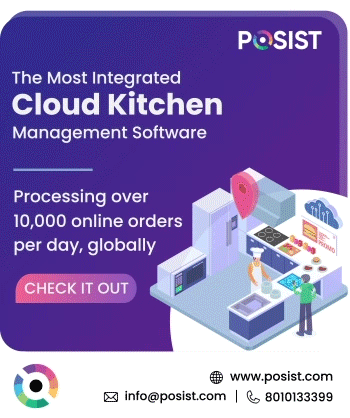Restaurant menu pricing is an essential step while opening a restaurant simply because any restaurant business earns the most from the food it sells, and menu prices are nothing more than little price tags attached to each dish you make. One needs to give monetary value to the services and to do so, you need to put the prices on your restaurant menu. That is why calculating the right price is crucial for only your restaurant’s profitability but longevity as well. The menu pricing strategy also helps to determine the demographics your restaurant attracts, how often do they visit, if they will continue to dine at your establishment, and of course, how much profit your restaurant will generate. In this article, we will discuss effective restaurant menu pricing strategies that will help you build a profitable restaurant menu.
- Understanding restaurant menu pricing
- Factors affecting the menu prices
- Things to consider while finalizing the menu costs
- Restaurant menu pricing techniques and strategies
1. Menu Pricing 101: What Is Menu Pricing Or Menu Costs
Deciding your menu costs, better known by the term “Menu Pricing” is the process of calculating the price at which you want to sell different dishes at your restaurant. When you decide your menu cost, you calculate the cost to prepare the dish along with other overhead expenses that go into making the dish. This is when you arrive at the final price at which you sell your dish. This selling price covers your costs as well as brings profits.
For accurate restaurant menu pricing, you must look at various factors which influence menu costs and then decide on a menu pricing strategy.
2. Factors That Affect Restaurant Menu Pricing
There are various factors that will affect your menu prices. In any restaurant worldwide, the factors influencing menu costs don’t change, but the magnitude of influence keeps shifting. That is true even within the same country and the same state. The factors affecting menu costs on the West Coast will be different, in scale and magnitude, when compared to those on the East Coast. Thus, you must account for each of these carefully before going on to deciding your tentative price, calculating your food cost percentage or gross profit percentage, or even considering which menu pricing strategy to use. The factors which affect menu prices are:-
(i) Direct Costs
Direct costs are the cost of raw material. For a restaurant, there are three branches to direct costs. These are –
- The cost at which the ingredients are brought. Your direct costs do not include the cost of transporting the raw material or the cost of labor to procure the raw material; it is strictly the price of the raw material which forms your restaurant inventory only.
- Cost related to food waste. You must account for the cost of wasted food as a direct cost as it still forms a part of your inventory and has a direct impact on the inventory levels.
- Cost related to portion sizes. The variance which occurs while portioning your food and managing your yield is to be added to the direct cost of your raw materials.
The higher your direct costs are, the more your menu price will be for a given profit margin. Similarly, the higher your direct costs are, the lesser your profit margin will be at a given menu price.
(ii) Indirect Costs
These are the costs which you encounter to prepare a dish excluding the cost of raw material. In simpler terms, indirect costs are the cost of adding value and quality to your food and dining experience at your restaurant. These include things like the cost of tableware, cutlery, ambiance, lighting, water supply, etc.
Labor expenses are an exclusive part of your indirect costs. The labor that goes into making and serving dishes must be included as salaries. Even when you prepare your Profit & Loss Statement, your labor costs will come under the heading of salaries credited, but following the definition of indirect costs, the salaries and wages which you pay to your staff members to prepare and serve the meals, and to run the restaurant, are a part of your indirect costs and must be considered while pricing the menu.
(iii) Overhead Expenses
These are the expenses you encounter in running your restaurant. These are different from indirect costs as overhead expenses include expenditures that will impact the restaurant directly. For example, the marketing budget of the restaurant or the renovation cost of the restaurant is an overhead expense.
You must factor in your overhead expenses while deciding your menu pricing strategy as the only way in which your restaurant can earn is through the food it sells. No matter what the source of the cost or the expense, in the end, if it is made to push the restaurant and the restaurant’s food, it must be considered in a while deciding the menu cost.
(iv) Seasonal Costs
These are the costs that are volatile and change according to the season. They are accommodated within direct costs, indirect costs, and overhead expenses while calculating your menu price and food costs. But that does not mean that you must not pay attention to the fact that some of your costs will face seasonal ups and downs. This is because the menu you create needs to be balanced. Every dish must have some ingredients which are cheap, easy to acquire and have relatively stable prices.
At the same time, the menu must be a mix of different types of dishes being sold at different price levels. The reason you consider your seasonal costs is not just to find the right price for a dish but to find the right balance of dishes within the menu, and the right balance of ingredients within a dish. Your seasonal costs will mostly include what you pay for ingredients like meat, fruits, and vegetables as the prices of these items can fluctuate depending upon the season.
(iv) Service Costs
Service costs can have a direct impact on your restaurant menu prices and can raise or lower them. If you run a fast-casual or a self-service restaurant in the U.S, your service costs will be much lower than what they would have been for a fine dining restaurant. Don’t over-price here as the quality of service must do justice to the prices or else you will lose your customers.
(v) Competitor Pricing
The price that your competitors are charging for the same dish has a significant impact on your menu pricing strategy. You cannot charge more than your competitors unless you are giving exceptional value for the extra charge. At the same time, pricing lower than the industry rates may also have a significant impact on your profits even if it attracts customers. Thus, knowing what the competitors are charging will let you have a rough idea regarding the price bracket in which your menu costs should ideally lie.
(vii) Customer Psychology
The psychology of your target audience is not something you can factor in your menu prices using a formula, yet while deciding the menu cost, you must consider the psychology of your target audience. Your prices must not reflect negatively on the restaurant’s image, but at the same time must entice your customers and feel worth the experience. Price your dishes too high, and you may lose some customers, as they might not find the food worth the cost. At the same time, price all your dishes too low and the customers may get an impression that your food is not that good.
Basic Concepts You Must Understand To Price Your Restaurant Menu
To get your restaurant menu pricing right, you need to have an understanding of four basic concepts. These are:-
- Food Cost Percentage: Food cost percentage is the amount invested per dollar earned. For example, if your food cost percentage is 30%, it means that for every dollar made, 3 cents are a part of the costs. In the restaurant industry in the USA, a 25-30% food cost percentage is considered ideal. To find out your potential food cost, divide the total costs by total sales and multiply it by 100, that is –
Food Cost Percentage= (Total Costs/Total Sales) X 100
- Gross Profit Percentage: Gross profit percentage is the amount you earn as a proportion of total sales in relation to the cost of creating the dish. But this figure does not factor in your fixed expenses as it is derived from the cost of goods sold which includes only the variable expenses. This means that if the gross profit percentage is 30% then for every dollar earned, 3 cents are the gross profits. A typical gross profit percentage for restaurants in the USA is 33%, but it is better to keep this figure as high as possible. To calculate your gross profit margin, deduct your cost of goods sold (COGS) from your total sales, divide it by the total sales and multiply the figure by 100.
Gross Profit Percentage= [( Total Sales – COGS)/ Total Sales] X 100
- Net Profit Percentage: This is the actual profit percentage that a restaurant earns as it is derived from profit after you have paid all the expenses. Thus, it is the percentage of net profit that the restaurant earns per dollar earned in sales. This means that if the net profit percentage is 30% then for every dollar earned, 3 cents is the net profit. Your net profit percentage will always be less than your gross profit percentage. To calculate your net profit percentage, find your net profit, divide it by total sales and multiply the figure by 100.
Net Profit= Total Sales – COGS – Total Fixed Costs.
Net Profit Percentage= (Net Profit/Total Sales) X 100
- Markup Percentage: Markup percentage is the increase on the original selling price. The markup sales are expressed as a percentage to ensure that the restaurant receives a proper amount of gross profit margin. The purpose of the markup percentage is to find the ideal sales price for your dishes. To calculate your markup percentage, divide your gross profit by your unit cost and multiply the figure by 100.
Markup Percentage= (Gross Profit/ Unit Cost) X 100
According to a report by the National Restaurant Association and Deloitte & Touche LLP, a restaurant’s net profit margins vary by restaurant type and the restaurant’s average dinner check. Hence as a restaurant owner in the United States, where competition is ripe, and people love their deals, you must strike a balance between your profit percentage, markup percentage, and food cost percentage. At the same time, you cannot go around changing your restaurant menu pricing strategy very often, or else you will lose your customers to your competitors. Hence a basic understanding of these concepts will enable you to make an informed decision.
3. Restaurant Menu Pricing Strategies To Follow For Deciding The Item Selling Price
Three basic menu pricing strategies are used in the USA restaurant industry to decide the menu costs. These are:-
(i) Traditional Menu Pricing
These are pricing strategies that used to be followed when more reliable methods of calculating prices were not that popular, the competition was less, and the target audience was not that diverse. Traditional pricing methods marked the nascent stage of the restaurant sector in America. Players like KFC, Mcdonald’s, Starbucks, and the like changed the pricing game and turned the traditional pricing methods into mere factors to consider. Even for independent restaurants in the USA, these methods are not recommended to be used as the absolute authority to decide your menu costs. Traditional menu pricing methods include:-
- Intuition: Using the price which feels right by experience.
- Competition: Using the price followed by the competitors.
- Leader Prices: Using the price followed by the industry leader.
- Customer Psychology: Using the price which you think the customers would be ready to spend.
While not to be used as ultimate factors to base your restaurant menu pricing strategy on, you must consider these factors as they will play a role in finalizing your carefully and numerically calculated menu costs.
(ii) Cost Plus Markup Pricing
This menu pricing strategy involves an understanding of the concepts of markup percentage, gross profit percentage, and net profit percentage. In this menu pricing method, you take the cost that goes into making a dish and add to it a markup cost based on your markup percentage.
For example, if it costs $10 to make a dish, and you desire your gross profit percentage to be 30% you should work with a markup price that is slightly higher than that so that your net profit percentage comes close to that figure. Let’s say your markup percentage is 35% so you will sell the dish for $45.
At this stage consider your competitor pricing, leader pricing, and customer psychology to tweak the price accordingly.
(iii) Competition Pricing Method
For competitive pricing, you must track what your competitors are charging and price your menu items based on that analysis. Simply get a few menus from your competitors, and depending on the kind of restaurant you run, choose to price your menu similar to it, lower, or higher.
If you want to sell to people who care more about price, you should lower your prices. If you are a direct competitor and sell to the same type of customer, you should set your prices the same. If you are a new industry player with many rivals, you might try out this price strategy to see how your customers respond.
Time will show you who your ideal customers are and how they differ from those of your competitors.
(iv) Demand-Drive Pricing Method
Prices could go up depending on how many people want to eat at your restaurant and what food they want. You can raise your prices if your restaurant has a great atmosphere and brand or if it serves unique and delicious food. This could also raise demand for you because you offer food and a setting people can’t get anywhere else.
So, for example, you may have noticed that food prices at airports and clubs are a little higher than in other places because they know people don’t have any other option (in case of airports) and they won’t get this experience anywhere else (in the case of clubs). So, there is a lot of demand.
In the same way, restaurants with a unique menu and a pleasant atmosphere can use this pricing method because they know that customers will pay for good food and a friendly atmosphere.
Arriving at the correct menu price may seem like a tedious task, and you can hire an expert if you are not too good with numbers. Nonetheless, you must not ignore its value and invest considerable time in deciding a menu pricing strategy for your restaurant.




















